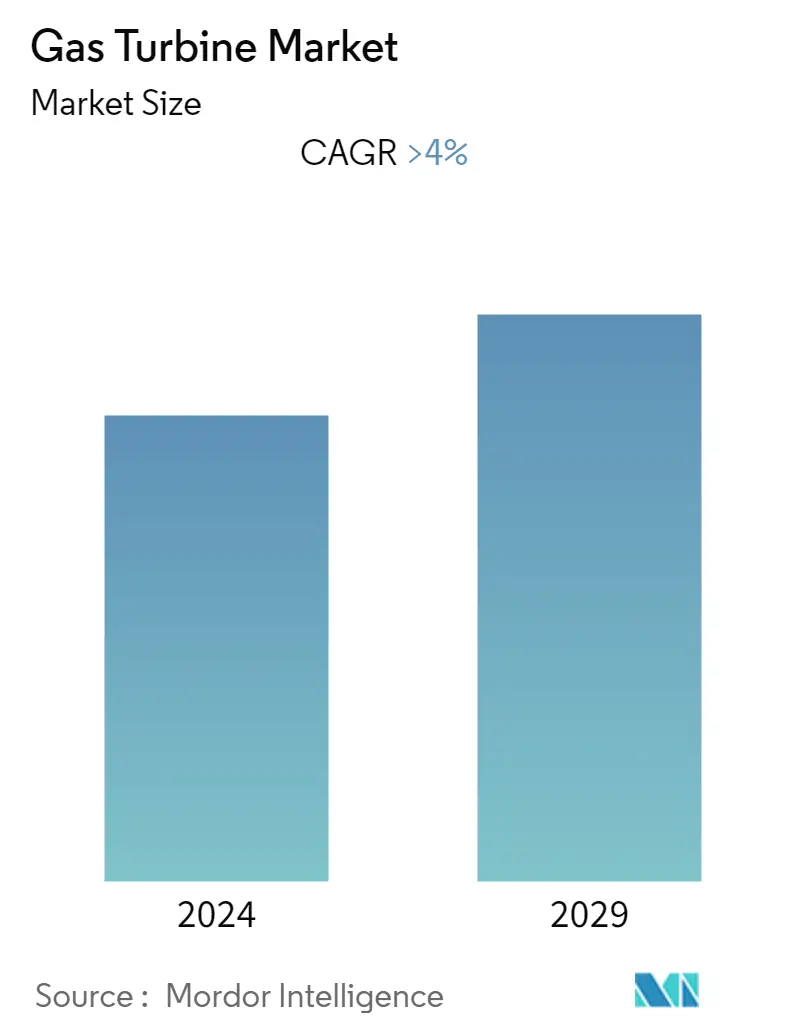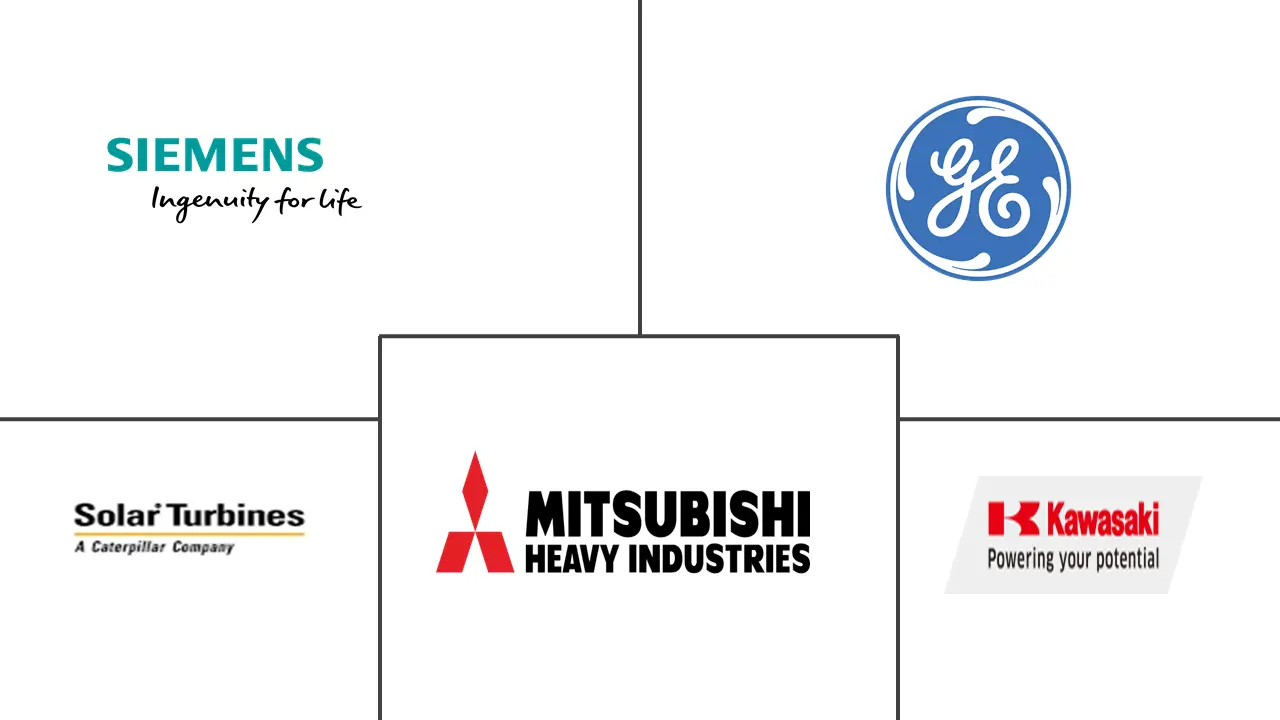Market Size of Gas Turbine Industry

| Study Period | 2021 - 2029 |
| Base Year For Estimation | 2023 |
| CAGR | 4.00 % |
| Fastest Growing Market | Asia-Pacific |
| Largest Market | Asia-Pacific |
| Market Concentration | Low |
Major Players
*Disclaimer: Major Players sorted in no particular order |
Gas Turbine Market Analysis
The global gas turbine market is expected to record a CAGR of 4% during the forecast period.
The market was negatively impacted by the COVID-19 pandemic. However, the market has now reached pre-pandemic levels.
Factors such as lower operating costs, lower emissions, and high-power density are expected to drive the market's growth. Increasing demand for electricity across the world, advancements in the technologies leading to an increase in shale gas production, and various countries opting for the generation of power through gas-fired plants are expected to drive the global gas turbine market's growth.
However, increasing renewable energy deployments, especially in countries like the United States, China, Brazil, and India, are expected to hinder the growth of the gas turbine market.
There is a rise in demand for natural gas-fired plants and global initiatives across the countries for the reduction in emission of carbon dioxide, based on the technology. The combined cycle segment would provide significant opportunities to the market due to its overall electrical efficiency, typically ranging from 50-60% compared to open cycle with 33%.
Asia-Pacific is witnessing substantial growth in the demand for gas turbines during the forecast period, primarily due to growing concerns about increasing pollution levels in the region.
Gas Turbine Industry Segmentation
A gas turbine, also called a combustion turbine, is a continuous-flow internal combustion engine that uses natural gas to generate electricity.
The global gas turbine market is segmented by capacity, type, end-user industry, and geography. By capacity, the market is segmented into less than 30 MW, 31-120 MW, and above 120 MW. By type, the market is segmented into combined and open cycles. By end-user industry, the market is segmented into power, oil and gas, and other end-user Industries. The report also covers the market size and forecasts for the gas turbine market across the major regions. For each segment, the market sizing and forecasts have been done based on revenue (USD billion).
| By Capacity | |
| Less than 30 MW | |
| 31-120 MW | |
| Above 120 MW |
| By Type | |
| Combined Cycle | |
| Open Cycle |
| By End-User Industry | |
| Power | |
| Oil and Gas | |
| Other End-user Industries |
| By Geography | |
| Asia-Pacific | |
| North America | |
| Europe | |
| South America | |
| Middle East and Africa |
Gas Turbine Market Size Summary
The global gas turbine market is poised for growth, driven by factors such as reduced operating costs, lower emissions, and high power density. The market has rebounded to pre-pandemic levels after the setbacks caused by COVID-19. The increasing demand for electricity worldwide, coupled with technological advancements that boost shale gas production, is propelling the market forward. Many countries are shifting towards gas-fired power generation, which is seen as a more environmentally friendly option compared to coal and nuclear power. However, the rise of renewable energy sources in regions like the United States, China, Brazil, and India poses a challenge to the market's expansion. The combined cycle segment, known for its higher electrical efficiency, is expected to offer significant opportunities for growth.
In the Asia-Pacific region, the demand for gas turbines is experiencing substantial growth due to rising pollution concerns. Countries such as Japan, Russia, and Germany are implementing measures to reduce carbon emissions, which is likely to enhance the adoption of gas-fired power plants. The trend towards distributed power generation and the replacement of outdated nuclear and coal plants are also contributing to market expansion. Rapid industrialization and urbanization in countries like India, China, Japan, and Myanmar are driving increased power demand, leading to the development of numerous power projects. The market is moderately fragmented, with key players including Siemens AG, Mitsubishi Heavy Industries Ltd, General Electric Company, Kawasaki Heavy Industries Ltd, and Wartsila Oyj Abp, who are actively involved in significant projects worldwide.
Gas Turbine Market Size - Table of Contents
-
1. MARKET OVERVIEW
-
1.1 Scope of the Study
-
1.2 Market Definition
-
1.3 Study Assumptions
-
-
2. MARKET OVERVIEW
-
2.1 Introduction
-
2.2 Market Size and Demand Forecast in USD billion, till 2027
-
2.3 Recent Trends and Developments
-
2.4 Market Dynamics
-
2.4.1 Drivers
-
2.4.2 Restraints
-
-
2.5 Supply-Chain Analysis
-
2.6 Porter's Five Forces Analysis
-
2.6.1 Bargaining Power of Suppliers
-
2.6.2 Bargaining Power of Consumers
-
2.6.3 Threat of New Entrants
-
2.6.4 Threat of Substitute Products and Services
-
2.6.5 Intensity of Competitive Rivalry
-
-
-
3. MARKET SEGMENTATION
-
3.1 By Capacity
-
3.1.1 Less than 30 MW
-
3.1.2 31-120 MW
-
3.1.3 Above 120 MW
-
-
3.2 By Type
-
3.2.1 Combined Cycle
-
3.2.2 Open Cycle
-
-
3.3 By End-User Industry
-
3.3.1 Power
-
3.3.2 Oil and Gas
-
3.3.3 Other End-user Industries
-
-
3.4 By Geography
-
3.4.1 Asia-Pacific
-
3.4.2 North America
-
3.4.3 Europe
-
3.4.4 South America
-
3.4.5 Middle East and Africa
-
-
Gas Turbine Market Size FAQs
What is the current Gas Turbine Market size?
The Gas Turbine Market is projected to register a CAGR of greater than 4% during the forecast period (2024-2029)
Who are the key players in Gas Turbine Market?
Siemens AG, Mitsubishi Heavy Industries Ltd, General Electric Company, Kawasaki Heavy Industries Ltd and Wartsila Oyj Abp are the major companies operating in the Gas Turbine Market.

